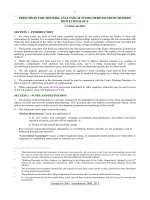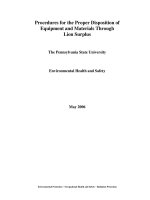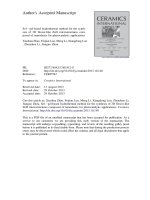ROMP based polymer nanoparticles for the targeted delivery of antitumor agents
Bạn đang xem bản rút gọn của tài liệu. Xem và tải ngay bản đầy đủ của tài liệu tại đây (11.8 MB, 53 trang )
Institute for
BioNanotechnology
in Medicine
ROMP-Based Polymer Nanoparticles
for The Targeted Delivery of
Antitumor Agents
Paul A. Bertin, DeeDee Smith, Julianne M. Gibbs,
Sang-Min Lee, Courtney Phillips, Emily Pentzer, and
SonBinh T. Nguyen
Department of Chemistry and Center for
Nanofabrication and Molecular Self-Assembly
Northwestern University, Evanston, IL 60208
Institute for
BioNanotechnology
in Medicine
Julianne M. Gibbs Paul A. Bertin
DeeDee Smith
Sang-Min Lee
Institute for
BioNanotechnology
in Medicine
Nanotechnology and Medicine
Chemistry
Physics
Engineering
Bio-
Nanotechnology
Biology
Medicine
Opportunities:
•
drug delivery
•
diagnostics
•
imaging
Challenges:
•
design insight
•
Multifunctional,
multiscale
synthesis
•
disease detection
•
improve therapy
Nanostructured
Tools
Inspiration
“Nanotechnology has the potential to make significant contributions to disease
prevention, detection, diagnosis, and treatment.” **
**
Srinivas, P. R. Laboratory Investigation 2002, 82, 657-662.
Institute for
BioNanotechnology
in Medicine
Hanahan, D.; Weinberg, R. A. Cell 2000, 100, 57-70.
*
American Cancer Society: www.cancer.org
Self-sufficiency
in growth signals
Insensitive to
anti-growth
signals
Evading
apoptosis
Sustained
angiogenesis
Tissue
invasion &
Metastasis
Infinite replicative
potential
Selectivity of existing cytotoxic chemotherapy for malignant cells over
healthy cells is low, resulting in life-threatening side effects.
How can selectivity be improved??
Cancer: An Attractive Target
2005 Projection: 1.37 million new cases in US
alone; 570,000 deaths
*
Institute for
BioNanotechnology
in Medicine
Motivation for Targeted Drug Delivery Research
•
Problems associated with small molecule drugs include:
–
Poor water solubility
–
Serious side effects from interaction with non-target cells
–
Rapidly eliminated from the body
–
Drug metabolism decreases activity and increases toxicity
•
Research efforts focus on the design of appropriate “bullets” to
address these problems
Soluble polymers
Microcapsules
Liposomes
Polymeric Micelles and Nanoparticles
Why do we need a “magic bullet”?
Institute for
BioNanotechnology
in Medicine
1. Core-shell structure 3. Spatial Recognition
2. Biocompatible 4. Temporal Structure
Adenovirus Type 2
Virus—A Natural Delivery Vehicle
Institute for
BioNanotechnology
in Medicine
Polymers as Functional Materials
F
F
F
F
F
F
F
F
•
Capitalize upon poly(F) as ‘amplified monomers’.
Inorganic &
Surface
Science
Organic &
Polymer
Chemistry
Biological
Chemistry
Institute for
BioNanotechnology
in Medicine
Advantages of Polymer Therapeutics
•
Increased solubility/stability
•
Reduced immunogenicity
•
Prolonged plasma half-lie through prevention and
avoidance of RES and MPS
•
Requires less frequent dosing
“Nanotechnology applied to medicine will bring significant advancement
to the treatment of cancer. These hybrid systems can be viewed as the
1st generation of nanomedicines.”
“Using advanced polymer chemistry and precision engineering at the
molecular level, together with an appreciation of the pathophysiology of
normal and disease tissue will help to realize the full therapeutic potential of
the post-genomics era.”
Duncan et al. TRENDS in Biotechnology 2006, 24, 39-47.
Institute for
BioNanotechnology
in Medicine
Passive Targeting Systems
PEO-b-p(Asp-Hyd-DOX)
Kataoka, K. et al. Angew. Chem. Int. Ed. 2003, 42, 4640-4643.
O NH
OH
O
NH
NH
O
HN
O
Ph
O
NH
N
H
O
O
HO
O
HO
O
HO
OH
HO
O
O
O
95 5
Duncan, R. et al. J. Controlled Release 1992, 19, 331-346.
HPMA
Peptide
Spacer
Doxorubicin
(DOX)
DOX
Hydrophobic
Hydrophilic
65 nm
combretastatin
Sengupta, S. et al. Nature 2005, 436, 568-572.
DOX-PLGA
PEG-liposome
“Nanocell”
200 nm
PK1
Institute for
BioNanotechnology
in Medicine
Requirements for Drug Delivery
•
Drug delivery particle should self-assemble from drug
molecules, components for targeting, and components
for stability
•
Particle size should enable effective penetration in target
tissue and cells (< 400 nm for tumor tissue)
•
Drug delivery particles should be stable and biologically
inert before reaching their target
•
Drug release should result from interactions with the
target cells
•
Components of drug delivery system should easily be
removed from the organism
Institute for
BioNanotechnology
in Medicine
Polymeric Nanoparticles as Model
Drug Delivery Vehicles
Institute for
BioNanotechnology
in Medicine
Magic Bullet?
•
Core-shell nanostructures with control over morphology, size, and size distribution
•
Incorporate multiple therapeutic agents (drug, DNA, protein), imaging agents, and penetrating
peptides into a biodegradable or removable (< 45 kDa) platform
•
Hydrophilic components should resist protein adsorption and prevent secondary aggregation
•
Targeting groups on the surface should allow for site-specific drug delivery
Ferrari, M. Nature Rev. Cancer 2005, 5, 161-171.
Advantage: multicomponent payload per biorecognition event
Institute for
BioNanotechnology
in Medicine
•
Equilibrium favors polymer formation due to the alleviation of ring
strain
•
Highly functional group tolerant, works at mild temperature
•
Amenable to the synthesis of monodisperse block copolymers
Ring-Opening Metathesis
Polymerization (ROMP)
Ru
Cl
Cl
PCy
3
PCy
3
CHPh
M
X
n
Y
Z
m
M
n
Z
X
m
Y
O
Y
X
M
+
n
Z
X
m
Y
n
Institute for
BioNanotechnology
in Medicine
OH
Aldrich - 55% endo
X
H
X
+
Diels-Alder - >85% endo
OH
O
O
OH
O
KOH
100% exo
X
X
Keith J. Watson
A Versatile ROMP Synthon: 100%
exo-Norbornen-2-ol
Institute for
BioNanotechnology
in Medicine
A Toolbox for Monomer Development
OH
O
Cl
n
O
O
OH
O
O
I
O
Br
>120 new monomers for ROMP
Watson et al.
Institute for
BioNanotechnology
in Medicine
ROMP-Based Nanostructures
self-assembly
amphiphilic block copolymers
biocompatible
group
drug
≤ 400 nm
drug
Ru
CHPh
Cl
Cl
PCy
3
PCy
3
hydrophobic
hydrophilic
Institute for
BioNanotechnology
in Medicine
Block Copolymer Synthesis
HN
O
N
O
Cl
O
O
1. Grubbs P(Cy
3
)
2
Ph
n
IND
Ru*
O
2. m PEO
3.
Ph
n
m
IND
PEO
(a)
(b)
n m M
n
PDI
(a) 35 - 17,100 1.21
(b) 35 35 31,500 1.08
GPC
Bertin, P. A. et al. Macromolecules 2004, 37, 8364-8372.
Institute for
BioNanotechnology
in Medicine
Preparation of Polymeric Nanoparticles
Ph
n
m
IND
PEO
H
2
O
1.
2.
3.
X wt % in DMSO
Dialysis
0.001 wt%
IND
35
-b-PEO
15
0.01 wt%
IND
35
-b-PEO
15
0.1 wt%
IND
35
-b-PEO
15
•
Copolymers dissolved in
DMSO
•
H
2
O is added dropwise to
stirring soln. (0.35 wt
%/drop) up to 15 wt%
•
Onset of micellization
determined by SLS
•
Dialyzed to remove DMSO
•
Characterization by TEM,
DLS, SLS, AFM,
1
H-NMR
Bertin, P. A. et al. Macromolecules 2004, 37, 8364-8372.
Institute for
BioNanotechnology
in Medicine
166 nm
Evidence of Core-Shell Structure
Ph
35
15
IND
PEO
1. DMSO
2. Dialysis
CDCl
3
1. Lyophilize
2. D
2
O
CDCl
3
Bertin, P. A. et al.
Macromolecules 2004, 37,
8364-8372.
Bertin
Institute for
BioNanotechnology
in Medicine
In Vitro Drug Release
In vitro release of indomethacin from copolymer
IND
35
-b-PEO
7
nanoparticles after 48 h in pH = 3.0
H
2
O/DMSO (4:1, v/v) at () 25 °C and (♦) 37 °C.
After 48 h at pH=3.0, 20% of the indomethacin is released.
Bertin, P. A.; Watson, K. J.; Nguyen, S. T. Macromolecules 2004, 37, 8364-8372.
pH = 3.0
Dialysis Experiment
Institute for
BioNanotechnology
in Medicine
Synthesis of Monomers
Bertin, P., Smith, D., Nguyen, S. T. Chem. Comm. 2005, 3793-3795
PEO conjugated norbornene
Doxorubicin norbornene
(carbamate-linked)
Carbamate is stable at
pH 7.4, and is
hydrolyzed at pH 5 and
below.
Institute for
BioNanotechnology
in Medicine
Polymer Synthesis
Bertin, P., Smith, D., Nguyen, S. T. Chem. Comm. 2005, 3793-3795
PEO
15
PEO
15
-b-DOX
15
1.121794916259
PEO
15
-b-
DOX
15
1.19102366300
PEO
15
PDI
M
w
(Daltons)
M
n
(Daltons)
Polymer
Theoretical M
w
of PEO
15
-b-DOX
15
= 17901
Institute for
BioNanotechnology
in Medicine
Nanoparticle Formation
Bertin, P., Smith, D., Nguyen, S. T. Chem. Comm. 2005, 3793-3795
Particles show narrow size
distribution around 230 nm
Institute for
BioNanotechnology
in Medicine
In Vitro Release of Doxorubicin
1. Incubate in H
+
2. Centrifuge 30 min 10k rpm
3. Measure Abs of supernatant
at 480 nm
5.5% release of doxorubicin at pH 5 after 24 h 50% release of doxorubicin at pH 4 after 24 h
Release at pH 5 Release at pH 4
Bertin, P., Smith, D., Nguyen, S. T. Chem. Comm. 2005, 3793-3795
Institute for
BioNanotechnology
in Medicine
DAPI+DOX
DOX
DIC+DOX
DIC
63X
still on the
cell membrane
With Clifton Shen
Passive Uptake









